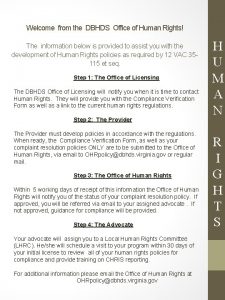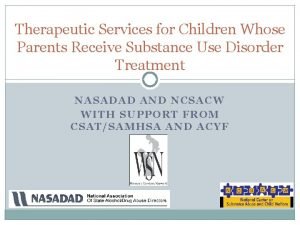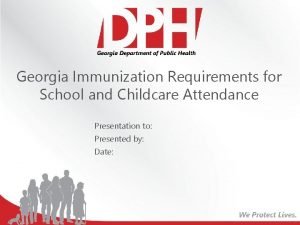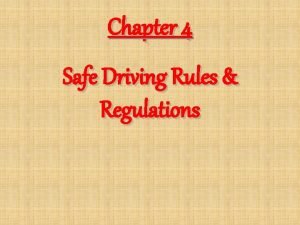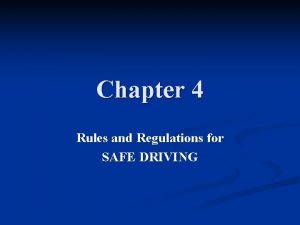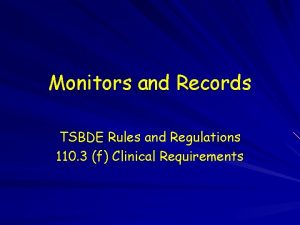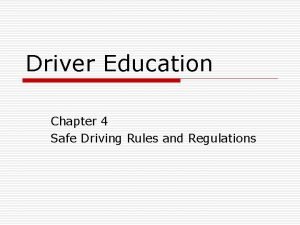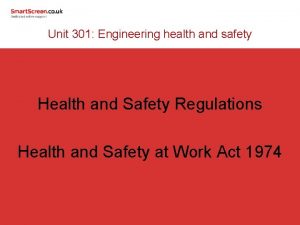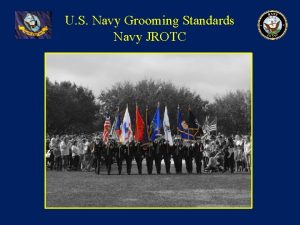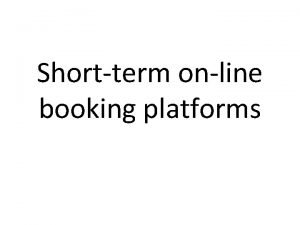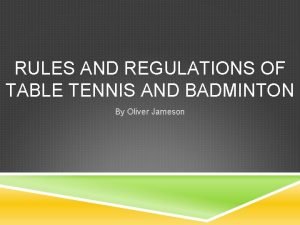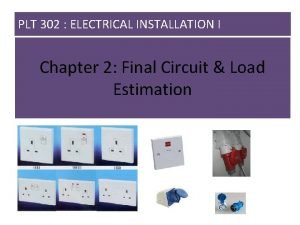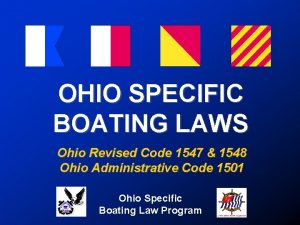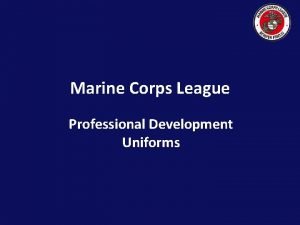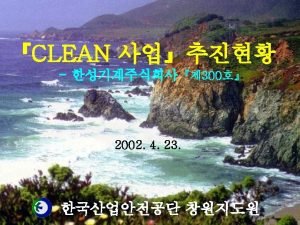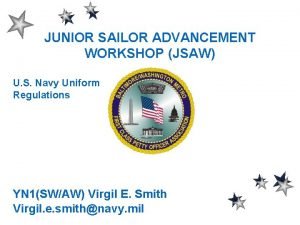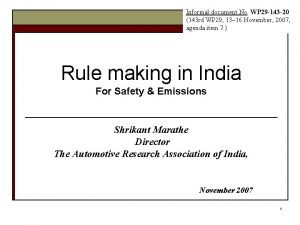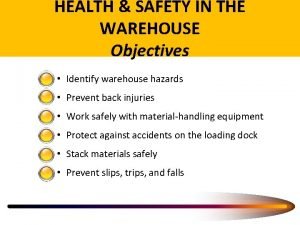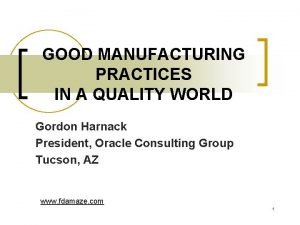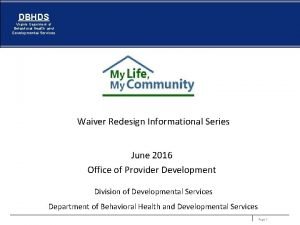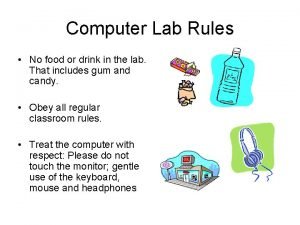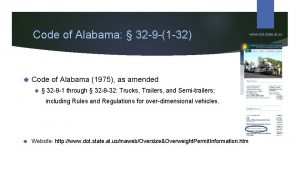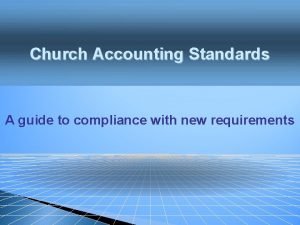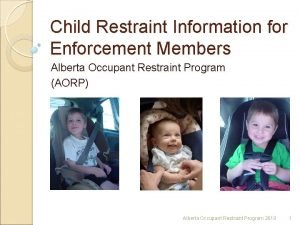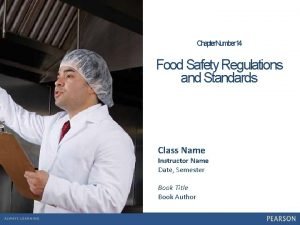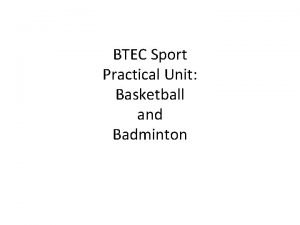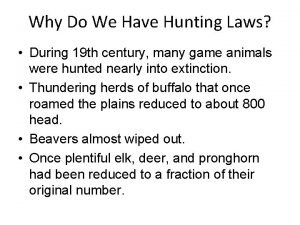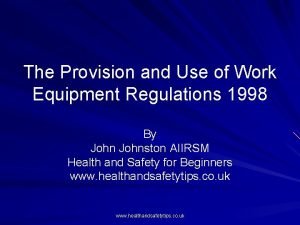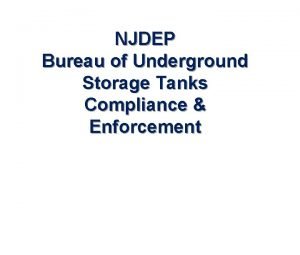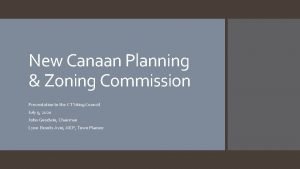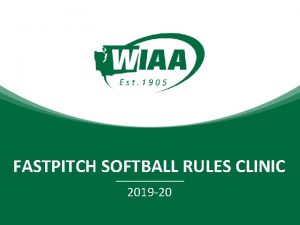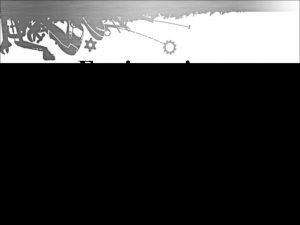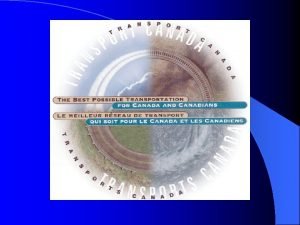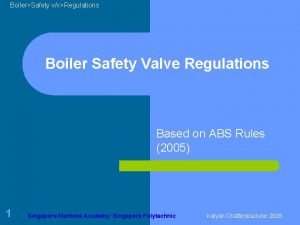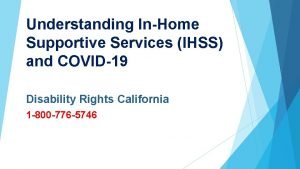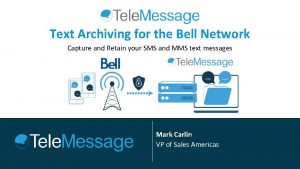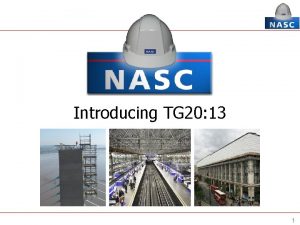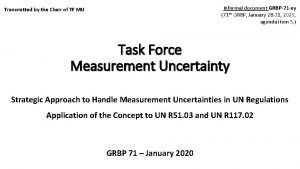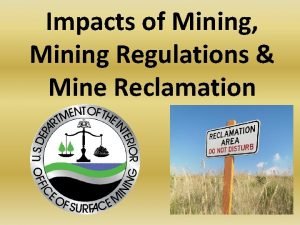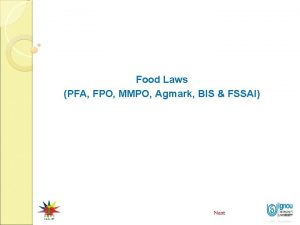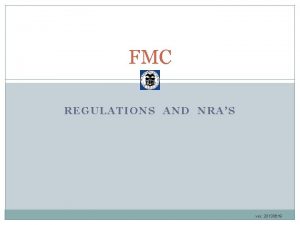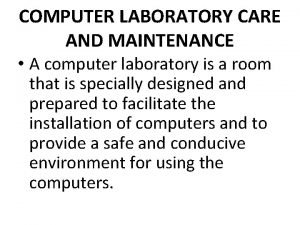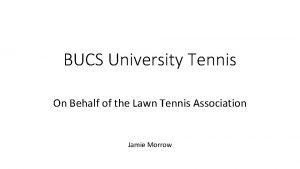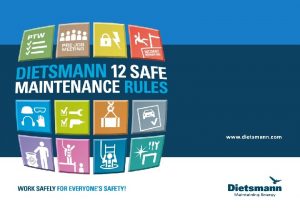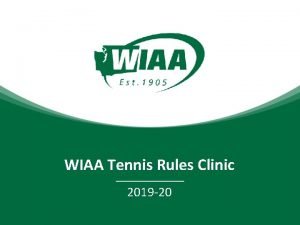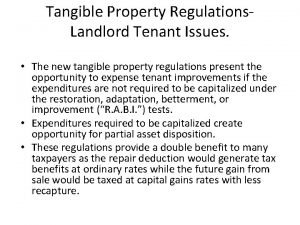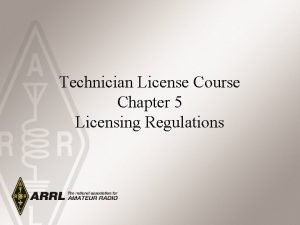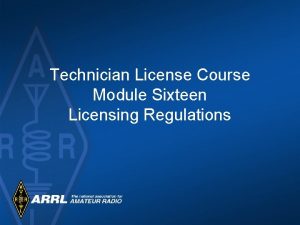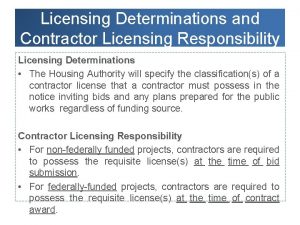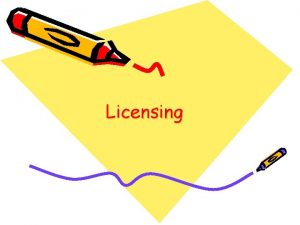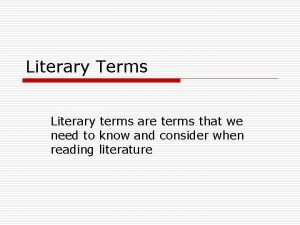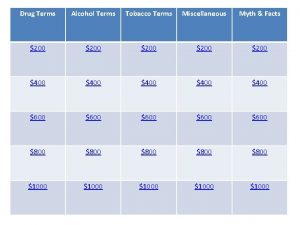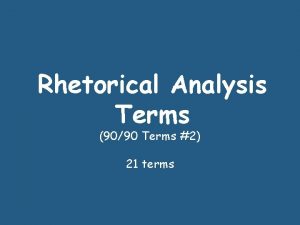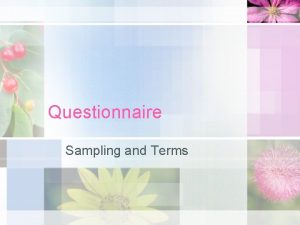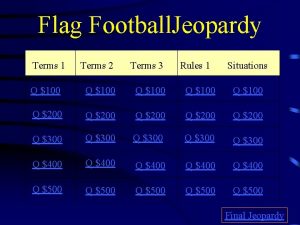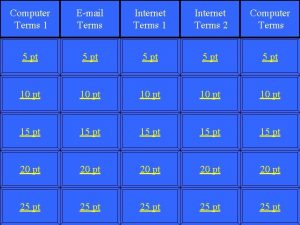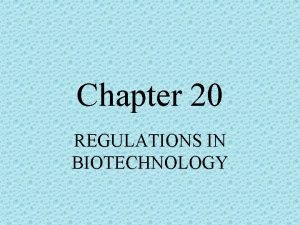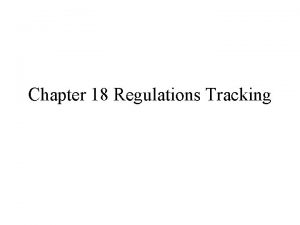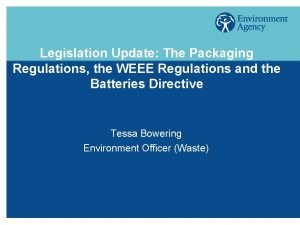Chapter 7 Licensing Regulations Licensing Terms The licensing



































![T 1 A 01 -- [97. 1] Which of the following is a purpose T 1 A 01 -- [97. 1] Which of the following is a purpose](https://slidetodoc.com/presentation_image_h2/a9b001d2fb6e3d57220e0774b2480899/image-36.jpg)
![T 1 A 04 -- [97. 5(b)(1)] How many operator / primary station license T 1 A 04 -- [97. 5(b)(1)] How many operator / primary station license](https://slidetodoc.com/presentation_image_h2/a9b001d2fb6e3d57220e0774b2480899/image-37.jpg)
![T 1 C 01 - [97. 9(a), 97. 17(a)] For which license classes are T 1 C 01 - [97. 9(a), 97. 17(a)] For which license classes are](https://slidetodoc.com/presentation_image_h2/a9b001d2fb6e3d57220e0774b2480899/image-38.jpg)
![T 1 F 11 - [97. 5(b)(2)] Which of the following is a requirement T 1 F 11 - [97. 5(b)(2)] Which of the following is a requirement](https://slidetodoc.com/presentation_image_h2/a9b001d2fb6e3d57220e0774b2480899/image-39.jpg)
![T 1 A 05 - [97. 7] What is proof of possession of an T 1 A 05 - [97. 7] What is proof of possession of an](https://slidetodoc.com/presentation_image_h2/a9b001d2fb6e3d57220e0774b2480899/image-40.jpg)
![T 1 C 10 - [97. 5 a] How soon after passing the examination T 1 C 10 - [97. 5 a] How soon after passing the examination](https://slidetodoc.com/presentation_image_h2/a9b001d2fb6e3d57220e0774b2480899/image-41.jpg)
![T 1 C 08 - [97. 25] What is the normal term for an T 1 C 08 - [97. 25] What is the normal term for an](https://slidetodoc.com/presentation_image_h2/a9b001d2fb6e3d57220e0774b2480899/image-42.jpg)
![T 1 C 09 - [97. 21(a)(b)] What is the grace period following the T 1 C 09 - [97. 21(a)(b)] What is the grace period following the](https://slidetodoc.com/presentation_image_h2/a9b001d2fb6e3d57220e0774b2480899/image-43.jpg)
![T 1 C 11 - [97. 21(b)] If your license has expired and is T 1 C 11 - [97. 21(b)] If your license has expired and is](https://slidetodoc.com/presentation_image_h2/a9b001d2fb6e3d57220e0774b2480899/image-44.jpg)
![T 1 C 07 - [97. 23] What may result when correspondence from the T 1 C 07 - [97. 23] What may result when correspondence from the](https://slidetodoc.com/presentation_image_h2/a9b001d2fb6e3d57220e0774b2480899/image-45.jpg)
![T 1 F 01 - [97. 103(c)] When must the station licensee make the T 1 F 01 - [97. 103(c)] When must the station licensee make the](https://slidetodoc.com/presentation_image_h2/a9b001d2fb6e3d57220e0774b2480899/image-46.jpg)
















![T 1 B 03 - [97. 301(a)] Which frequency is within the 6 meter T 1 B 03 - [97. 301(a)] Which frequency is within the 6 meter](https://slidetodoc.com/presentation_image_h2/a9b001d2fb6e3d57220e0774b2480899/image-63.jpg)
![T 1 B 04 - [97. 301(a)] Which amateur band are you using when T 1 B 04 - [97. 301(a)] Which amateur band are you using when](https://slidetodoc.com/presentation_image_h2/a9b001d2fb6e3d57220e0774b2480899/image-64.jpg)
![T 1 B 06 - [97. 301(e), 97. 305] On which HF bands does T 1 B 06 - [97. 301(e), 97. 305] On which HF bands does](https://slidetodoc.com/presentation_image_h2/a9b001d2fb6e3d57220e0774b2480899/image-65.jpg)
![T 1 B 10 - [97. 301(e), 97. 305(c)] Which of the following HF T 1 B 10 - [97. 301(e), 97. 305(c)] Which of the following HF](https://slidetodoc.com/presentation_image_h2/a9b001d2fb6e3d57220e0774b2480899/image-66.jpg)
![T 1 A 06 - [97. 3(a)(9)] What is the FCC Part 97 definition T 1 A 06 - [97. 3(a)(9)] What is the FCC Part 97 definition](https://slidetodoc.com/presentation_image_h2/a9b001d2fb6e3d57220e0774b2480899/image-67.jpg)
![T 1 B 05 - [97. 305(c)] What is the limitation for emissions on T 1 B 05 - [97. 305(c)] What is the limitation for emissions on](https://slidetodoc.com/presentation_image_h2/a9b001d2fb6e3d57220e0774b2480899/image-68.jpg)
![T 1 B 07 - [97. 305(a), (c)] Which of the following VHF/UHF frequencies T 1 B 07 - [97. 305(a), (c)] Which of the following VHF/UHF frequencies](https://slidetodoc.com/presentation_image_h2/a9b001d2fb6e3d57220e0774b2480899/image-69.jpg)
![T 1 B 11 - [97. 313] What is the maximum peak envelope power T 1 B 11 - [97. 313] What is the maximum peak envelope power](https://slidetodoc.com/presentation_image_h2/a9b001d2fb6e3d57220e0774b2480899/image-70.jpg)
![T 1 B 12 - [97. 313(b)] Except for some specific restrictions, what is T 1 B 12 - [97. 313(b)] Except for some specific restrictions, what is](https://slidetodoc.com/presentation_image_h2/a9b001d2fb6e3d57220e0774b2480899/image-71.jpg)
![T 1 B 08 - [97. 303] Which of the following is a result T 1 B 08 - [97. 303] Which of the following is a result](https://slidetodoc.com/presentation_image_h2/a9b001d2fb6e3d57220e0774b2480899/image-72.jpg)
![T 1 A 08 - [97. 3(a)(22)] Which of the following entities recommends transmit/receive T 1 A 08 - [97. 3(a)(22)] Which of the following entities recommends transmit/receive](https://slidetodoc.com/presentation_image_h2/a9b001d2fb6e3d57220e0774b2480899/image-73.jpg)
![T 1 A 09 - [97. 3(a)(22)] Who selects a Frequency Coordinator? A. The T 1 A 09 - [97. 3(a)(22)] Who selects a Frequency Coordinator? A. The](https://slidetodoc.com/presentation_image_h2/a9b001d2fb6e3d57220e0774b2480899/image-74.jpg)












![T 1 C 03 - [97. 117] What types of international communications is an T 1 C 03 - [97. 117] What types of international communications is an](https://slidetodoc.com/presentation_image_h2/a9b001d2fb6e3d57220e0774b2480899/image-87.jpg)
![T 1 D 01 - [97. 111(a)(1)] With which countries are FCC-licensed amateur stations T 1 D 01 - [97. 111(a)(1)] With which countries are FCC-licensed amateur stations](https://slidetodoc.com/presentation_image_h2/a9b001d2fb6e3d57220e0774b2480899/image-88.jpg)
![T 1 C 04 - [97. 107] When are you allowed to operate your T 1 C 04 - [97. 107] When are you allowed to operate your](https://slidetodoc.com/presentation_image_h2/a9b001d2fb6e3d57220e0774b2480899/image-89.jpg)
![T 1 C 06 - [97. 5(a)(2)] From which of the following locations may T 1 C 06 - [97. 5(a)(2)] From which of the following locations may](https://slidetodoc.com/presentation_image_h2/a9b001d2fb6e3d57220e0774b2480899/image-90.jpg)









![T 1 C 02 - [97. 19] Who may select a desired call sign T 1 C 02 - [97. 19] Who may select a desired call sign](https://slidetodoc.com/presentation_image_h2/a9b001d2fb6e3d57220e0774b2480899/image-100.jpg)



- Slides: 103

Chapter 7 Licensing Regulations

Licensing Terms The licensing and regulating authority for US amateurs is the Federal Communications Commission (FCC). The FCC Regulations are found in: • • • Title 47 of the Code of Federal Regulations (CFR). The primary regulations governing the Amateur Radio Service are found in: • • Part 97 of the FCC Regulations.

Why is there amateur radio? § 97. 1 Basis and purpose. - The rules and regulations in this Part are designed to provide an amateur radio service having a fundamental purpose as expressed in the following principles: (a)Recognition and enhancement of the value of the amateur service to the public as a voluntary noncommercial communication service, particularly with respect to providing emergency communications. (b) Continuation and extension of the amateur's proven ability to contribute to the advancement of the radio art.

Why is There Amateur Radio? (c) Encouragement and improvement of the amateur service through rules which provide for advancing skills in both the communications and technical phases of the art. (d) Expansion of the existing reservoir within the amateur radio service of trained operators, technicians, and electronics experts. (e) Continuation and extension of the amateur's unique ability to enhance international goodwill.

Definitions § 97. 3 Definitions. (a)The definitions of terms used in part 97 are: (4) Amateur service. A radiocommunication service for the purpose of self-training, intercommunication and technical investigations carried out by amateurs, that is, duly authorized persons interested in radio technique solely with a personal aim and without pecuniary interest.

Definitions § 97. 3 Definitions. (a) The definitions of terms used in part 97 are: (1) Amateur operator. A person named in an amateur operator/primary license station grant on the ULS consolidated licensee database to be the control operator of an amateur station. (2) Amateur station. A station in an amateur radio service consisting of the apparatus necessary for carrying on radiocommunications.

The Amateur License • No age limit or citizenship restrictions. • 9 – 90 in 2015 class • Not a representative of a foreign government. • License actually contains two parts. • Operator License. • Station License (the call sign). (not an independent authorization) • Each person may hold only one primary station license grant

The Amateur License DO NOT COUNT ON A PAPER COPY

The Amateur License • As of February 17, 2015, the FCC no longer routinely issues paper license documents to Amateur Radio applicants and licensees. • New applicants will not automatically receive a license document and must request one by changing their “Paper Authorization Preference” in the ULS License Manager. • Official indication of a license is when the control operator's operator/primary station license appears in the FCC ULS consolidated licensee database. • You can also print a copy from the ULS system with an “Official Copy” “watermark” printed on it.


The Amateur License • Currently three levels (classes) of operator privileges are being issued: • Technician Class. • All privileges above 50 MHz. • Limited HF privileges. • General Class. • Privileges on all amateur bands. • Amateur Extra Class. • All amateur privileges.

The Amateur License • Previous classes of operator privileges: • No longer being issued, but may continue to be renewed. • Novice Class. • Entry-level license. • Limited CW privileges on 80 m, 40 m, 15 m, & 10 m. • Limited phone privileges on 10 m, 1. 25 m, & 23 cm. • Advanced Class. • More phone privileges than General Class. • Technician Plus. • Technician license issued before March 21, 1987 can get an instant upgrade to General.

The Amateur License • Club call signs. • Amateur radio clubs can have their own call signs. • Club must have a minimum of 4 members & an organizational document. • License is issued to a trustee designated by the club. • Includes NO privileges. • Control Operator privileges convey.

Examinations • Three multiple-choice examinations allow earning the three classes of license. License Class Element 2 Element 3 Element 4 (35 Questions) (50 Questions) Technician X General X X Amateur Extra X X X

Examinations • All questions used on the examinations are chosen from a published question pool. • A passing grade of 74% is required. • For Technician & General, you must correctly answer 26 of the 35 questions. • For Amateur Extra, you must correctly answer 37 of the 50 questions.

Examinations • Examinations are administered by a team of at least 3 Volunteer Examiners (VE’s). • General or higher class license. • At least 18 years of age. • License never suspended or revoked. • VE’s are accredited by an organization known as a Volunteer Examiner Coordinator (VEC).

Examinations • VE’s forward examination session paperwork to VEC for processing. • VEC uploads successful candidate information to FCC for licensing.

Examinations • 14 VEC’s recognized by FCC. • ARRL-VEC. • Largest. • W 5 YI-VEC. • 2 nd largest. • Laurel-VEC. • 3 rd largest.

Examinations • All 14 VECs are members of the National Conference of Volunteer Examiner Coordinators (NCVEC). • Maintains question pools. • Provides standardized application form. • NCVEC Form 605. • Represents VEC’s before the FCC.

NCVEC Form 605 • Used by all VEC’s. • VEC’s may modify by adding logo, but basic form is the same. • Replaces FCC Form 605. • Single page & easy to understand. • FCC form is 26 pages plus attachments.

Taking the Examination • Study the material. • Go over the question pools. • Find a test session. • ARRL website gives list of test sessions registered with them. • http: //www. arrl. org/exam_sessions/search • Not just sessions coordinated by ARRL-VEC. • Register for the test session if required.

Taking the Examination • Bring the following to the test session: • Photo ID. • Some VE teams may require 2 forms of ID. • Original of your license (if any). • Some VE teams may require a photocopy of your license, which they will keep. • Original of any CSCE’s you have. • Examination fee (if any). • Check or exact change preferred.

Taking the Examination • Bring the following to the test session: • Pen (to fill out application form). • Pencil (to fill out answer sheets). • You can use a pen if you are REALLY confident! • Calculator. • If programmable, memory must be cleared. • Obey ALL instructions from the VE team!

Taking the Examination • When you complete an element, the VE team will immediately grade the element and inform you of the results. • Some VEC’s do not allow the VE team to advise candidates of which questions were missed. • At least one VEC encourages VE teams to review missed questions with the candidate.

Taking the Examination • When you have completed all of the elements you wish to take at that session, the VE team will issue to you a Certificate of Successful Completion of Examination (CSCE) as long as you have passed at least 1 element or are qualified for a higher class license.

Taking the Examination • The CSCE will indicate the elements that were successfully passed at that session and any licenses you are qualified for. • If the CSCE is for your initial license, you cannot operate until your name & call sign appear in the FCC Universal Licensing System (ULS) database. • You have to know what your call sign is! • This is the formal proof of an FCC issued license grant!

Taking the Examination • A CSCE indicating an upgrade of an existing license serves as authority to use the new privileges immediately. • Special identification required while using new privileges. • • “<call>/KT” if upgrade to Technician Class. “<call>/AG” means Authorized General. “<call>/AE” means Authorized Extra. Can drop special identification once new privileges appear in the FCC database.

The CSCE • Each VEC has their own unique design CSCE. • The CSCE is valid for element credit for a period of 365 days. • A CSCE indicating an upgrade of an existing license serves as authority to use the new privileges immediately.

The CSCE SAMPLE

License Term & Renewal • License is valid for a period of 10 years. • License may be renewed up to 90 days prior to expiration date. • An expired license may be renewed up to 2 years (grace period) after the expiration date without retaking the examination(s). • License is NOT valid during the grace period. • You may NOT transmit during the grace period.

Licensee Responsibilities • Prevent unauthorized operation of your station. • Provide personal information to the FCC as required. • Maintain a current mailing address on file. • An invalid mailing address can result in license suspension/revocation. • Make your station available for FCC inspection upon request.

Working with the FCC • The Universal Licensing System (ULS). • Comprehensive database of ALL licenses issued by the FCC’s Wireless Telecommunications Bureau (WTB). • http: //wireless. fcc. gov/uls • By registering with the ULS, you can: • • View your license information. Modify your personal information (address, etc. ) Renew your license. Search other licenses.

Working with the FCC • Registering with the ULS. • You can register BEFORE you get your license. • You will be issued a Federal Registration Number (FRN). • If you have an FRN, always use your FRN and not your Social Security number on the NCVEC Form 605. • If you have an FRN, you can indicate to the FCC to always sent a paper copy!

Working with the FCC

T 1 A 02 -- Which agency regulates and enforces the rules for the Amateur Radio Service in the United States? A. FEMA B. Homeland Security C. The FCC D. All of these choices are correct
![T 1 A 01 97 1 Which of the following is a purpose T 1 A 01 -- [97. 1] Which of the following is a purpose](https://slidetodoc.com/presentation_image_h2/a9b001d2fb6e3d57220e0774b2480899/image-36.jpg)
T 1 A 01 -- [97. 1] Which of the following is a purpose of the Amateur Radio Service as stated in the FCC rules and regulations? • • Providing personal radio communications for as many citizens as possible Providing communications for international non-profit organizations Advancing skills in the technical and communication phases of the radio art All of these choices are correct
![T 1 A 04 97 5b1 How many operator primary station license T 1 A 04 -- [97. 5(b)(1)] How many operator / primary station license](https://slidetodoc.com/presentation_image_h2/a9b001d2fb6e3d57220e0774b2480899/image-37.jpg)
T 1 A 04 -- [97. 5(b)(1)] How many operator / primary station license grants may be held by any one person? A. One B. No more than two C. One for each band on which the person plans to operate D. One for each permanent station location from which the person plans to operate new
![T 1 C 01 97 9a 97 17a For which license classes are T 1 C 01 - [97. 9(a), 97. 17(a)] For which license classes are](https://slidetodoc.com/presentation_image_h2/a9b001d2fb6e3d57220e0774b2480899/image-38.jpg)
T 1 C 01 - [97. 9(a), 97. 17(a)] For which license classes are new licenses currently available from the FCC? A. Novice, Technician, General, Advanced B. Technician, Technician Plus, General, Advanced C. Novice, Technician Plus, General, Advanced D. Technician, General, Amateur Extra new
![T 1 F 11 97 5b2 Which of the following is a requirement T 1 F 11 - [97. 5(b)(2)] Which of the following is a requirement](https://slidetodoc.com/presentation_image_h2/a9b001d2fb6e3d57220e0774b2480899/image-39.jpg)
T 1 F 11 - [97. 5(b)(2)] Which of the following is a requirement for the issuance of a club station license grant? A. The trustee must have an Amateur Extra class operator license grant B. The club must have at least four members C. The club must be registered with the American Radio Relay League D. All of these choices are correct new
![T 1 A 05 97 7 What is proof of possession of an T 1 A 05 - [97. 7] What is proof of possession of an](https://slidetodoc.com/presentation_image_h2/a9b001d2fb6e3d57220e0774b2480899/image-40.jpg)
T 1 A 05 - [97. 7] What is proof of possession of an FCCissued operator/primary license grant? A. A printed operator/primary station license issued by the FCC must be displayed at the transmitter site B. The control operator must have an operator/primary station license in his or her possession when in control of a transmitter C. The control operator's operator/primary station license must appear in the FCC ULS consolidated licensee database D. All of these choices are correct new
![T 1 C 10 97 5 a How soon after passing the examination T 1 C 10 - [97. 5 a] How soon after passing the examination](https://slidetodoc.com/presentation_image_h2/a9b001d2fb6e3d57220e0774b2480899/image-41.jpg)
T 1 C 10 - [97. 5 a] How soon after passing the examination for your first amateur radio license may you operate a transmitter on an Amateur Radio Service frequency? A. Immediately B. 30 days after the test date C. As soon as your name and call sign appear in the FCC’s ULS database D. You must wait until you receive your license in the mail from the FCC
![T 1 C 08 97 25 What is the normal term for an T 1 C 08 - [97. 25] What is the normal term for an](https://slidetodoc.com/presentation_image_h2/a9b001d2fb6e3d57220e0774b2480899/image-42.jpg)
T 1 C 08 - [97. 25] What is the normal term for an FCC issued primary station/operator license grant? A. B. C. D. Five years Life Ten years Twenty years
![T 1 C 09 97 21ab What is the grace period following the T 1 C 09 - [97. 21(a)(b)] What is the grace period following the](https://slidetodoc.com/presentation_image_h2/a9b001d2fb6e3d57220e0774b2480899/image-43.jpg)
T 1 C 09 - [97. 21(a)(b)] What is the grace period following the expiration of an amateur license within which the license may be renewed? A. B. C. D. Two years Three years Five years Ten years
![T 1 C 11 97 21b If your license has expired and is T 1 C 11 - [97. 21(b)] If your license has expired and is](https://slidetodoc.com/presentation_image_h2/a9b001d2fb6e3d57220e0774b2480899/image-44.jpg)
T 1 C 11 - [97. 21(b)] If your license has expired and is still within the allowable grace period, may you continue to operate a transmitter on amateur service frequencies? A. No, transmitting is not allowed until the ULS database shows that the license has been renewed B. Yes, but only if you identify using the suffix “GP” C. Yes, but only during authorized nets D. Yes, for up to two years
![T 1 C 07 97 23 What may result when correspondence from the T 1 C 07 - [97. 23] What may result when correspondence from the](https://slidetodoc.com/presentation_image_h2/a9b001d2fb6e3d57220e0774b2480899/image-45.jpg)
T 1 C 07 - [97. 23] What may result when correspondence from the FCC is returned as undeliverable because the grantee failed to provide and maintain a correct mailing address with the FCC? A. Fine or imprisonment B. Revocation of the station license or suspension of the operator license C. Require the licensee to be re-examined D. A reduction of one rank in operator class new
![T 1 F 01 97 103c When must the station licensee make the T 1 F 01 - [97. 103(c)] When must the station licensee make the](https://slidetodoc.com/presentation_image_h2/a9b001d2fb6e3d57220e0774b2480899/image-46.jpg)
T 1 F 01 - [97. 103(c)] When must the station licensee make the station and its records available for FCC inspection? A. At any time ten days after notification by the FCC of such an inspection B. At any time upon request by an FCC representative C. Only after failing to comply with an FCC notice of violation D. Only when presented with a valid warrant by an FCC official or government agent new

Bands and Privileges Power Limits § 97. 313(a) An amateur station must use the minimum transmitter power necessary to carry out the desired communications.

Power Limits • Maximum of 1500 watts peak envelope power (PEP). • Normally requires an external amplifier. • Some cases where power is restricted. • • 60 m: ≤ 100 Watts PEP. 30 m: ≤ 200 Watts PEP. Novices & Technicians ≤ 200 Watts on HF. Other special situations.

Frequency Privileges • Review: Amateur bands are named after their approximate wavelength.

Frequency Privileges • Technician Class VHF & UHF privileges. VHF UHF Band (Wavelength) Frequency Limits 6 m 50 -54 MHz 2 m 144 -148 MHz 1. 25 m 219 -220 MHz 222 -225 MHz 70 cm 420 -450 MHz 33 cm 902 -928 MHz 23 cm 1240 -1300 MHz 13 cm 2300 -2310 MHz 2390 -2450 MHz

Frequency Privileges • Technician Class HF privileges. Band (Wavelength) Frequency Limits Mode 80 m 3525 -3600 k. Hz CW 40 m 7025 -7125 k. Hz CW 15 m 21. 025 -21. 150 MHz CW 10 m 28. 000 -28. 300 MHz 28. 300 -28. 500 MHz CW, Data, Phone

Frequency Privileges • Primary & secondary allocations. • Some frequencies are shared with other services. • Primary user. • Has priority on use of frequency. • Secondary user. • Must not cause interference to primary user. • Must accept interference from primary user.

Emission Privileges

Emission Privileges • Technician class. • All emission privileges on VHF & UHF. • Limited emission privileges on HF.

Emission Privileges • Emission frequency limits. • On some bands, certain emissions may only be used in a specified portion of the band. • Bands with emission frequency limitations are: • HF -- 80 m, 40 m, 20 m, 17 m, 15 m, 12 m, & 10 m. • VHF -- 6 m, 2 m, 1. 25 m.


Emission Privileges • The following segments on the HF bands are restricted to CW & data only: Band 80 m 40 m Segment 3. 500 -3. 600 MHz 3. 525 -3. 600 MHz* 7. 000 -7. 125 MHz 7. 025 -7. 125 MHz* Band Segment 17 m 18. 068 -18. 110 MHz 15 m 21. 000 -21. 200 MHz 21. 025 -21. 200 MHz* 30 m (entire band) 12 m 24. 890 -25. 930 MHz 20 m 14. 000 -14. 150 MHz 10 m 28. 000 -28. 300 MHz • * Indicates Technician class limit • On 60 m the entire band is restricted to CW, Data, & USB only.

Emission Privileges • Beacons • Another type of station restricted to certain sub-bands. These stations make transmissions for the purpose of observing propagation or other experiments. • You will find them on 10 meters between 28. 2 and 28. 3 MHz and in the lower segments of the VHF, UHF, and microwave bands.

Emission Privileges • Restricted segments on the VHF bands are: • 6 m: 50. 0 MHz to 50. 1 MHz – CW only. • 2 m: 144. 0 MHz to 144. 1 MHz – CW only. • 1. 25 m: 219. 0 MHz to 220 MHz – Data only. • Fixed digital message forwarding systems only. • 50 Watts PEP maximum power output. • 100 k. Hz maximum bandwidth.

Repeater Coordination • Because repeaters cannot easily change frequency, coordination is desirable to avoid unnecessary interference. • Each area or region establishes a repeater coordinator who advises repeater operators on repeater frequencies & CTCSS tones. • The repeater coordinator is selected by the amateur operators in the area who are eligible to operate repeaters.

Repeater Coordination ● Repeater Coordinator for GA, KY, MS, NC, SC, TN, VA and WV is South. Eastern Repeater Association, Inc. (SERA). • Note that AL is not included! ● Sometimes called Frequency Coordinator. (this is not testable material)

Repeater Coordination • The term repeater coordinator is defined in the FCC regulations [§ 97. 3(a)(22)]. • Repeater coordination is not required by the FCC regulations, but…. . § 97. 101(a) In all respects not specifically covered by FCC Rules each amateur station must be operated in accordance with good engineering and good amateur practice.
![T 1 B 03 97 301a Which frequency is within the 6 meter T 1 B 03 - [97. 301(a)] Which frequency is within the 6 meter](https://slidetodoc.com/presentation_image_h2/a9b001d2fb6e3d57220e0774b2480899/image-63.jpg)
T 1 B 03 - [97. 301(a)] Which frequency is within the 6 meter amateur band? A. B. C. D. 49. 00 MHz 52. 525 MHz 28. 50 MHz 222. 15 MHz
![T 1 B 04 97 301a Which amateur band are you using when T 1 B 04 - [97. 301(a)] Which amateur band are you using when](https://slidetodoc.com/presentation_image_h2/a9b001d2fb6e3d57220e0774b2480899/image-64.jpg)
T 1 B 04 - [97. 301(a)] Which amateur band are you using when your station is transmitting on 146. 52 MHz? A. 2 meter band B. 20 meter band C. 14 meter band D. 6 meter band
![T 1 B 06 97 301e 97 305 On which HF bands does T 1 B 06 - [97. 301(e), 97. 305] On which HF bands does](https://slidetodoc.com/presentation_image_h2/a9b001d2fb6e3d57220e0774b2480899/image-65.jpg)
T 1 B 06 - [97. 301(e), 97. 305] On which HF bands does a Technician class operator have phone privileges? A. None B. 10 meters only C. 80 meters, 40 meters, 15 meters and 10 meters D. 30 meters only new
![T 1 B 10 97 301e 97 305c Which of the following HF T 1 B 10 - [97. 301(e), 97. 305(c)] Which of the following HF](https://slidetodoc.com/presentation_image_h2/a9b001d2fb6e3d57220e0774b2480899/image-66.jpg)
T 1 B 10 - [97. 301(e), 97. 305(c)] Which of the following HF bands have frequencies available to the Technician class operator for RTTY and data transmissions? A. 10 meters, 12 meters, 17 meters, and 40 meters B. 10 meters, 15 meters, 40 meters, 80 meters C. 30 meters only D. 10 meters only new
![T 1 A 06 97 3a9 What is the FCC Part 97 definition T 1 A 06 - [97. 3(a)(9)] What is the FCC Part 97 definition](https://slidetodoc.com/presentation_image_h2/a9b001d2fb6e3d57220e0774b2480899/image-67.jpg)
T 1 A 06 - [97. 3(a)(9)] What is the FCC Part 97 definition of a "beacon"? A. A government transmitter marking the amateur radio band edges B. A bulletin sent by the FCC to announce a national emergency C. An amateur station transmitting communications for the purposes of observing propagation or related experimental activities D. A continuous transmission of weather information authorized in the amateur bands by the National Weather Service new
![T 1 B 05 97 305c What is the limitation for emissions on T 1 B 05 - [97. 305(c)] What is the limitation for emissions on](https://slidetodoc.com/presentation_image_h2/a9b001d2fb6e3d57220e0774b2480899/image-68.jpg)
T 1 B 05 - [97. 305(c)] What is the limitation for emissions on the frequencies between 219 and 220 MHz? A. Spread spectrum only B. Fixed digital message forwarding systems only C. Emergency traffic only D. Fast-scan television only new
![T 1 B 07 97 305a c Which of the following VHFUHF frequencies T 1 B 07 - [97. 305(a), (c)] Which of the following VHF/UHF frequencies](https://slidetodoc.com/presentation_image_h2/a9b001d2fb6e3d57220e0774b2480899/image-69.jpg)
T 1 B 07 - [97. 305(a), (c)] Which of the following VHF/UHF frequencies ranges are limited to CW only? A. 50. 0 MHz to 50. 1 MHz and 144. 0 MHz to 144. 1 MHz B. 219 MHz to 220 MHz and 420. 0 MHz to 420. 1 MHz C. 902. 0 MHz to 902. 1 MHZ D. All of these choices are correct new
![T 1 B 11 97 313 What is the maximum peak envelope power T 1 B 11 - [97. 313] What is the maximum peak envelope power](https://slidetodoc.com/presentation_image_h2/a9b001d2fb6e3d57220e0774b2480899/image-70.jpg)
T 1 B 11 - [97. 313] What is the maximum peak envelope power output for Technician class operators using their assigned portions of the HF bands? A. 200 watts B. 100 watts C. 50 watts D. 10 watts new
![T 1 B 12 97 313b Except for some specific restrictions what is T 1 B 12 - [97. 313(b)] Except for some specific restrictions, what is](https://slidetodoc.com/presentation_image_h2/a9b001d2fb6e3d57220e0774b2480899/image-71.jpg)
T 1 B 12 - [97. 313(b)] Except for some specific restrictions, what is the maximum peak envelope power output for Technician class operators using frequencies above 30 MHz? A. 50 watts B. 100 watts C. 500 watt D. 1500 watts new
![T 1 B 08 97 303 Which of the following is a result T 1 B 08 - [97. 303] Which of the following is a result](https://slidetodoc.com/presentation_image_h2/a9b001d2fb6e3d57220e0774b2480899/image-72.jpg)
T 1 B 08 - [97. 303] Which of the following is a result of the fact that the Amateur Radio Service is secondary in all or portions of some amateur bands (such as portions of the 70 cm band)? A. U. S. amateurs may find non-amateur stations in those portions, and must avoid interfering with them B. U. S. amateurs must give foreign amateur stations priority in those portions C. International communications are not permitted in those portions D. Digital transmissions are not permitted in those portions new
![T 1 A 08 97 3a22 Which of the following entities recommends transmitreceive T 1 A 08 - [97. 3(a)(22)] Which of the following entities recommends transmit/receive](https://slidetodoc.com/presentation_image_h2/a9b001d2fb6e3d57220e0774b2480899/image-73.jpg)
T 1 A 08 - [97. 3(a)(22)] Which of the following entities recommends transmit/receive channels and other parameters for auxiliary and repeater stations? A. B. C. D. Frequency Spectrum Manager Frequency Coordinator FCC Regional Field Office International Telecommunications Union
![T 1 A 09 97 3a22 Who selects a Frequency Coordinator A The T 1 A 09 - [97. 3(a)(22)] Who selects a Frequency Coordinator? A. The](https://slidetodoc.com/presentation_image_h2/a9b001d2fb6e3d57220e0774b2480899/image-74.jpg)
T 1 A 09 - [97. 3(a)(22)] Who selects a Frequency Coordinator? A. The FCC Office of Spectrum Management and Coordination Policy B. The local chapter of the Office of National Council of Independent Frequency Coordinators C. Amateur operators in a local or regional area whose stations are eligible to be auxiliary or repeater stations D. FCC Regional Field Office

International Rules • International Telecommunications Union (ITU). • United Nations Agency. • Information and communications technology issues • Responsible for international radio regulations. • Responsible for radio frequency allocations. • Assigns call sign blocks.

International Rules • ITU Regions. • World divided into 3 regions. • Continental US is in Region 2. • Frequency allocations may be different in different regions. • Rules change at region boundaries regardless of country of license.

ITU Regions

International Amateur Radio Union (IARU) • International organization of national amateur radio societies. • IARU member for the US is ARRL. • Acts as voice for amateur radio before the ITU.

International Operating • You MAY operate your amateur radio station in another country, IF: • Other country allows amateur operations. • You have permission to operate in the foreign country.

International Operating • Types of permission. • International Amateur Permit (IARP). • Issued by IARU member-society. • Valid in: Argentina, Brazil, Canada, El Salvador, Panama, Peru, Trinidad and Tobago, United States of America, Uruguay, & Venezuela. • Two classes: • Class 1 - Equivalent to Amateur Extra license. • Class 2 - Equivalent to Technician license.

International Operating • Types of permission. • European Conference of Postal and Telecommunications Administrations (CEPT) radio-amateur license. • Valid in most European countries & their territories. • Must carry with you: • Original US license. • Proof of US citizenship (passport). • Copy of CEPT agreement.

International Operating • Types of permission. • Reciprocal operating authority. • Government-to-government agreement. • List of countries available on ARRL website. • http: //www. arrl. org/bilateral-reciprocal-agreements • May have to obtain formal permit from foreign country. • Identify using <host prefix>/<home call>. • e. g. – G 3/W 9 UUU or W 9/G 3 ABC

International Operating • Types of permission. • Automatic reciprocal operating authority. • Canada ONLY. • US amateurs can operate in Canada (and vice-versa) without any prior notification. • Identify using <home call>/<host prefix>. • e. g. – W 9 UUU/VE 3 or VE 3 ABC/W 9 • Backwards from rest of world!

International Operating • Operation from a vessel or craft in international waters or air space is determined by the rules of the country of registration of the vessel or craft. • If US registered, FCC rules apply. • If foreign registered, previously discussed permissions required.

International Operating • Unless prohibited by either country’s government, an amateur can talk to any other amateur in the world. • Country must notify ITU of objection. • Communications must be limited to: • Remarks of a personal character. • Incidental to the purposes of amateur radio.

T 1 B 01 - What is the International Telecommunications Union (ITU)? A. An agency of the United States Department of Telecommunications Management B. A United Nations agency for information and communications technology issues C. An independent frequency coordination agency D. A department of the FCC
![T 1 C 03 97 117 What types of international communications is an T 1 C 03 - [97. 117] What types of international communications is an](https://slidetodoc.com/presentation_image_h2/a9b001d2fb6e3d57220e0774b2480899/image-87.jpg)
T 1 C 03 - [97. 117] What types of international communications is an FCC-licensed amateur radio station permitted to make? A. Communications incidental to the purposes of the Amateur Radio Service and remarks of a personal character B. Communications incidental to conducting business or remarks of a personal nature C. Only communications incidental to contest exchanges, all other communications are prohibited D. Any communications that would be permitted by an international broadcast station
![T 1 D 01 97 111a1 With which countries are FCClicensed amateur stations T 1 D 01 - [97. 111(a)(1)] With which countries are FCC-licensed amateur stations](https://slidetodoc.com/presentation_image_h2/a9b001d2fb6e3d57220e0774b2480899/image-88.jpg)
T 1 D 01 - [97. 111(a)(1)] With which countries are FCC-licensed amateur stations prohibited from exchanging communications? A. Any country whose administration has notified the ITU that it objects to such communications B. Any country whose administration has notified the United Nations that it objects to such communications C. Any country engaged in hostilities with another country D. Any country in violation of the War Powers Act of 1934
![T 1 C 04 97 107 When are you allowed to operate your T 1 C 04 - [97. 107] When are you allowed to operate your](https://slidetodoc.com/presentation_image_h2/a9b001d2fb6e3d57220e0774b2480899/image-89.jpg)
T 1 C 04 - [97. 107] When are you allowed to operate your amateur station in a foreign country? A. When the foreign country authorizes it B. When there is a mutual agreement allowing third party communications C. When authorization permits amateur communications in a foreign language D. When you are communicating with non-licensed individuals in another country
![T 1 C 06 97 5a2 From which of the following locations may T 1 C 06 - [97. 5(a)(2)] From which of the following locations may](https://slidetodoc.com/presentation_image_h2/a9b001d2fb6e3d57220e0774b2480899/image-90.jpg)
T 1 C 06 - [97. 5(a)(2)] From which of the following locations may an FCC-licensed amateur station transmit? A. From within any country that belongs to the International Telecommunications Union B. From within any country that is a member of the United Nations C. From anywhere within International Telecommunications Union (ITU) Regions 2 & 3 D. From any vessel or craft located in international waters and documented or registered in the United States

Call Signs • ITU regulations specify that amateur radio call signs will have the following format. – Prefix. • 1 -3 characters denoting the country. – Number. • 1 or more digits. – Suffix. • 1 or more letters.

Call Signs • FCC regulations specify that U. S. amateur radio call signs will have the following format. – Prefix. • AA-AL, K, KA-KZ, N, NA-NZ, W, or WA-WZ. – Number. • Single digit (0 -9). • Denotes call district – maybe. – Suffix. • 1, 2, or 3 letters.

Call Signs • Not all combinations matching the above format are available to the amateur radio service. – e. g. – WX 9 ABC - Experimental station.

US Call Signs

Call Signs • Amateur radio call signs are divided into 4 groups according to operator license class. Group A B Available to License Class Amateur Extra Advanced General C Technician D Novice Available Formats Examples 1 x 2 W 3 AF 2 x 1 KC 4 F 2 x 2 beginning with A AA 4 AV 2 x 2 beginning with K, N, or W KE 4 UP 1 x 3 N 4 STU 2 x 3 beginning with K or W WD 0 FYV

Call Signs • Your call sign will probably be KO 4 IHx or KI 4 IIx • KO 4 IGA issued last on Oct 9 (~35 a day) • You can operate anywhere in the US with no special identification requirements. • You can add a self-assigned designator at the end of your call sign. – Cannot be the prefix for any country other than US.

Call Signs • Vanity call signs. – You can choose any available call sign. • Must have a sequential call in the ULS first. • Call must be in a group available to your class of operator license. – Vanity call sign currently has no fee. • After 10 years, must renew like everyone else.

Call Signs • Vanity call signs. – Call sign availability. • Never issued. • Expired or cancelled at least 2 years ago. – 2 -year rule does not apply to: » Previously held call sign. » Call sign of deceased close relative. » If club, call sign of deceased member.

Call Signs • Special event call signs. – A temporary call sign used during an event of significance to amateur radio. • Assigned by a Special Event Call Sign Administrator. • Not valid for more than 14 days. • 1 x 1 call sign. – Must identify with FCC call sign every hour.
![T 1 C 02 97 19 Who may select a desired call sign T 1 C 02 - [97. 19] Who may select a desired call sign](https://slidetodoc.com/presentation_image_h2/a9b001d2fb6e3d57220e0774b2480899/image-100.jpg)
T 1 C 02 - [97. 19] Who may select a desired call sign under the vanity call sign rules? A. Only a licensed amateur with a General or Amateur Extra class license B. Only a licensed amateur with an Amateur Extra class license C. Only a licensed amateur who has been licensed continuously for more than 10 years D. Any licensed amateur

T 1 C 05 - Which of the following is a valid call sign for a Technician class amateur radio station? A. K 1 XXX B. KA 1 X C. W 1 XX D. All of these choices are correct

Questions?

Schedule • Next Class (Feb 15) • W 3 AF Chapter 8 • AA 4 AV Chapter 9 • • Test session (Feb 22) Breakfast (Feb 29) General Class (Feb 29) Mini-Tech Session • • Apr 18 “I got my ticket…now what? ” Jul 11 Contest Station Setup and Ops Sep 19 Antenna setup and tuning Dec 5 Digital Technologies
 Virginia dbhds human rights regulations
Virginia dbhds human rights regulations Georgia child care licensing regulations
Georgia child care licensing regulations Ga form 3231 blank
Ga form 3231 blank Polynomial classification
Polynomial classification How to combine like terms
How to combine like terms If a motorist’s vehicle becomes disabled he/she must?
If a motorist’s vehicle becomes disabled he/she must? Chapter 4 safe driving rules and regulations
Chapter 4 safe driving rules and regulations Chapter 4 safe driving rules and regulations
Chapter 4 safe driving rules and regulations Tsbde rules and regulations chapter 110
Tsbde rules and regulations chapter 110 Chapter 4 safe driving rules and regulations
Chapter 4 safe driving rules and regulations Hát kết hợp bộ gõ cơ thể
Hát kết hợp bộ gõ cơ thể Slidetodoc
Slidetodoc Bổ thể
Bổ thể Tỉ lệ cơ thể trẻ em
Tỉ lệ cơ thể trẻ em Voi kéo gỗ như thế nào
Voi kéo gỗ như thế nào Chụp tư thế worms-breton
Chụp tư thế worms-breton Hát lên người ơi alleluia
Hát lên người ơi alleluia Các môn thể thao bắt đầu bằng tiếng bóng
Các môn thể thao bắt đầu bằng tiếng bóng Thế nào là hệ số cao nhất
Thế nào là hệ số cao nhất Các châu lục và đại dương trên thế giới
Các châu lục và đại dương trên thế giới Công thức tiính động năng
Công thức tiính động năng Trời xanh đây là của chúng ta thể thơ
Trời xanh đây là của chúng ta thể thơ Cách giải mật thư tọa độ
Cách giải mật thư tọa độ 101012 bằng
101012 bằng độ dài liên kết
độ dài liên kết Các châu lục và đại dương trên thế giới
Các châu lục và đại dương trên thế giới Thơ thất ngôn tứ tuyệt đường luật
Thơ thất ngôn tứ tuyệt đường luật Quá trình desamine hóa có thể tạo ra
Quá trình desamine hóa có thể tạo ra Một số thể thơ truyền thống
Một số thể thơ truyền thống Bàn tay mà dây bẩn
Bàn tay mà dây bẩn Vẽ hình chiếu vuông góc của vật thể sau
Vẽ hình chiếu vuông góc của vật thể sau Thế nào là sự mỏi cơ
Thế nào là sự mỏi cơ đặc điểm cơ thể của người tối cổ
đặc điểm cơ thể của người tối cổ Thế nào là giọng cùng tên
Thế nào là giọng cùng tên Vẽ hình chiếu đứng bằng cạnh của vật thể
Vẽ hình chiếu đứng bằng cạnh của vật thể Fecboak
Fecboak Thẻ vin
Thẻ vin đại từ thay thế
đại từ thay thế điện thế nghỉ
điện thế nghỉ Tư thế ngồi viết
Tư thế ngồi viết Diễn thế sinh thái là
Diễn thế sinh thái là Các loại đột biến cấu trúc nhiễm sắc thể
Các loại đột biến cấu trúc nhiễm sắc thể So nguyen to
So nguyen to Tư thế ngồi viết
Tư thế ngồi viết Lời thề hippocrates
Lời thề hippocrates Thiếu nhi thế giới liên hoan
Thiếu nhi thế giới liên hoan ưu thế lai là gì
ưu thế lai là gì Sự nuôi và dạy con của hổ
Sự nuôi và dạy con của hổ Sự nuôi và dạy con của hổ
Sự nuôi và dạy con của hổ Hệ hô hấp
Hệ hô hấp Từ ngữ thể hiện lòng nhân hậu
Từ ngữ thể hiện lòng nhân hậu Thế nào là mạng điện lắp đặt kiểu nổi
Thế nào là mạng điện lắp đặt kiểu nổi Health and safety regulations in engineering
Health and safety regulations in engineering Jrotc female hair
Jrotc female hair Food inspectors seize a minimum of ___ samples a month
Food inspectors seize a minimum of ___ samples a month Six pack health and safety regulations
Six pack health and safety regulations Stayz phillip island
Stayz phillip island Table tennis rules and regulations
Table tennis rules and regulations Ckt motor perlis
Ckt motor perlis Expired tags orc
Expired tags orc Class rules and regulations
Class rules and regulations Da pam 750-3
Da pam 750-3 Marine corps league red jacket
Marine corps league red jacket Korea kosha
Korea kosha Navy uniform stencil regulations
Navy uniform stencil regulations Automotive regulations and standards
Automotive regulations and standards Warehouse objectives
Warehouse objectives Gmp regulations
Gmp regulations Dbhds sponsored residential regulations
Dbhds sponsored residential regulations Cimah regulation 1996
Cimah regulation 1996 No food or drink near computers
No food or drink near computers Cold ironing regulations
Cold ironing regulations Alabama superload permits
Alabama superload permits Church accounting guidelines
Church accounting guidelines Alberta occupant restraint program
Alberta occupant restraint program Child care facility rules and regulations answers
Child care facility rules and regulations answers Food safety regulations and standards
Food safety regulations and standards Badminton regulations btec sport
Badminton regulations btec sport Irda (insurance brokers) regulations 2018 pdf
Irda (insurance brokers) regulations 2018 pdf Location planning in operations management
Location planning in operations management Why do we have hunting laws
Why do we have hunting laws Puwer reg 4
Puwer reg 4 Njdep compliance and enforcement
Njdep compliance and enforcement New canaan planning and zoning
New canaan planning and zoning Gso ro
Gso ro Wiaa fastpitch rules
Wiaa fastpitch rules H&s six pack
H&s six pack Dnv regulations for hospitals
Dnv regulations for hospitals Canadian motor vehicle safety standards
Canadian motor vehicle safety standards Boiler accumulation test
Boiler accumulation test Www cdss ca gov inforesources ssi/ssp
Www cdss ca gov inforesources ssi/ssp Bell sms archiving
Bell sms archiving Scaffolding regulations tg20
Scaffolding regulations tg20 R117 tyre regulations
R117 tyre regulations Mining regulations
Mining regulations Collective investment scheme regulations
Collective investment scheme regulations Mmpo act
Mmpo act Fmc regulations
Fmc regulations Computer laboratory rules and regulations
Computer laboratory rules and regulations Bwca rules and regulations
Bwca rules and regulations Bucs tennis regulations
Bucs tennis regulations Maintenance rules and regulations
Maintenance rules and regulations Wiaa football rules
Wiaa football rules Partial asset disposition
Partial asset disposition
